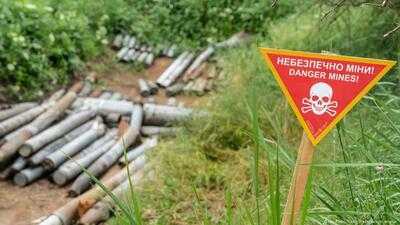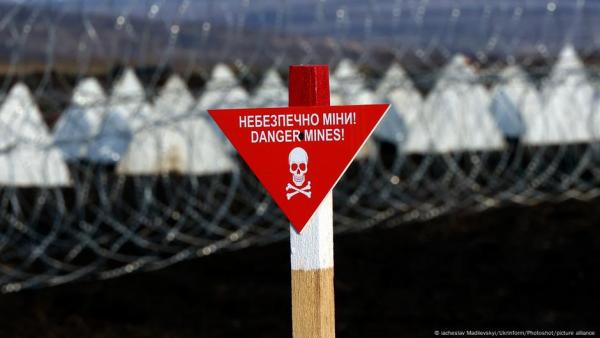

Five out of six countries along the border with Russia and Belarus plan to secure their borders with land mines, aiming to protect NATO's eastern flank from a possible attack. But the plan is highly controversial.Since the start of the Russian war of aggression against Ukraine in February 2022, there has hardly been a more pressing issue for NATO than the defense of its eastern borders. Over the past three years, five of the six NATO countries that share a border with Russia or Belarus — Finland, Estonia, Latvia, Lithuania and Poland— have already made significant investments to better secure these borders, for example with fences and surveillance systems. But now, a new plan is in the works: land mines. Eastern NATO member increase border security Those five NATO countries recently announced their withdrawal from the Ottawa Convention, the 1997 treaty which bans anti-personnel mines worldwide and prohibits their use, production and transfer. Only Norway, which shares a nearly 200-kilometer (124-mile) border with Russia, wants to stick to the treaty. Such mines are highly controversial, as they can be a danger for both soldiers and civilians. Uncleared mines remain a long-term threat after the end of a conflict: In 2023, nearly 6,000 people worldwide were killed or injured by land mines. Some 80% of the victims were civilians, including many children. Clearing these explosive devices is dangerous, expensive and extremely time-consuming. According to the nongovernmental organization Handicap International, 58 countries around the world and other areas are still contaminated with land mines, even if some of the underlying conflicts ended decades ago. From the end of 2025, these five NATO countries could restart the production and storage of anti-personnel mines near the border. In case of an emergency, these mines would then be deployed quickly. While 164 countries worldwide have signed the Ottawa Convention, 33 have not. In addition to the major powers US and China, this includes Russia. In fact, the Kremlin has by far the world's largest stockpile of anti-personnel mines, with an estimated 26 million. Many of these are already being used in Ukraine. New 'Iron Curtain' From Finnish Lapland in the north to the Polish province of Lublin in the south, the border between the five NATO states and Russia and Belarus is around 3,500 kilometers (2150 miles) long. Most of these areas are sparsely populated and densely forested, making them difficult to monitor the area. Nevertheless, there is great concern about a possible Russian attack on NATO territory. According to a report in the British newspaper The Telegraph, NATO experts are already analyzing which areas could be targeted. The aim of the NATO countries is to maximize deterrence: together with other border security measures, the mines are intended to inflict such heavy losses on the advancing enemy in the shortest possible time that Moscow would refrain from a prolonged war. Several million mines and other concealed explosives would likely be necessary to effectively protect the long border. Large areas would become uninhabitable for decades, and the potential damage to people and the environment is almost impossible to predict. David Blair, foreign correspondent for The Telegraph, described the plan as a new, explosive "Iron Curtain," alluding to the heavily guarded border between NATO and the Warsaw Pact states during the Cold War. In addition to mines, the eastern NATO states have already initiated many other measures, erecting or reinforcing border fences and walls, installing modern surveillance and early warning systems and strengthening troop contingents. Some of the countries are also planning to deploy drone defense systems along the border, and deepen irrigation systems so that they can be used as trenches in an emergency. They also aim to plant trees along important roads to provide camouflage for civilians and soldiers. Are land mines 'justified,' or indiscriminate threat? Lithuania, squeezed between the Russian exclave of Kaliningrad on the Baltic coast and Belarus in the east, is particularly vulnerable. A narrow, 65-kilometer land connection — the Suwalki Gap — links the Baltic states and Poland, making the area a likely target for a initial Russian attack. Vilnius, therefore, is planning to invest around €800 million ($937 million) in the production of new land mines in the coming years. Lithuanian Defense Minister Dovile Sakaliene has defended the strategy, speaking of the "existential threat" to her country. Russia has increasingly manufactured mines in recent years, she explained, while Europe had destroyed its own stockpiles under the terms of the Ottawa Convention. Eva Maria Fischer, head of advocacy at Handicap International Germany, believes the land mine plan is a dangerous and worrying development. "Of course, the security concerns of the Eastern European states may be justified in the current unstable international context," Fischer said in March, when Poland and the three Baltic states first announced their plans to withdraw from the treaty. "However, lasting security cannot be built on weapons that kill indiscriminately, remain in the ground long after the end of a conflict and continue to maim civilians and destroy livelihoods," she added. "There are alternatives to defending a country. These may seem more expensive, but they are not when you consider the enormous follow-up costs of using anti-personnel mines." This article was originally written in German.